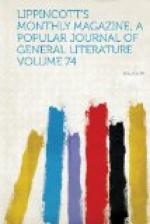the East. Indian armies have encamped beneath
its sheltering branches, and Hindoo festivals, to
which thousands of votaries repair, are often held
under its leafy shadow. I was told that
seven
thousand people could find ample shelter under
its widespread branches; and we often knew of English
gentlemen forming hunting or shooting excursions to
the island, and encamping for weeks together beneath
this delightful pavilion. Their only hosts were
frolicsome monkeys and whole colonies of doves, peacocks,
wood-pigeons and singing birds, that find a permanent
abode among the thick foliage, and plentiful sustenance
from the small, scarlet-colored figs that hang pendent
from every branch. The banian tree may be regarded
as a natural temple in Oriental regions, and the Hindoos
especially look upon it with profound veneration.
Tiny, fancifully-adorned temples and pagodas are erected
beneath its shadowy boughs, where are pleasant walks
and long vistas of umbrageous canopy, effectually shielded
from the fierce rays of the tropical sun. Many
Brahmins spend their entire lives within these quiet
retreats, and all ranks and classes seek them for
rest and recreation. The banian is styled also
“the tree of councils,” from the prevalent
custom of assembling legislators, magistrates and
savants under its protecting canopy to deliberate on
civil affairs; while all around, ensconced in every
niche, are the tutelary gods and goddesses that make
up the Hindoo mythology. It is indeed a quaint,
weird spot, full of the witchery of romance and legendary
lore; and though years have passed since I last sat
under the Cubber Burr’s sheltering boughs with
a merry party of picnicking maidens, now grown to
womanhood, imagination still loves to roam among its
shadows, and build fairy castles within the mazy windings
of the hoary banian of Nerbudda’s isle.
FANNIE R. FEUDGE.
A LOTOS OF THE NILE.
It was nine o’clock on a night of clear July
starlight. The heat of the day had been intense,
and all the guests of The Willows were assembled on
the lawn, intent upon the effort of keeping cool, if
such a thing were at all possible. A hopeless
effort it seemed, however, for the heavy foliage of
the trees hung quite motionless, and the fans which
were plied unceasingly made the only possible approach
to a breeze. Everything was so still that the
voice of the river was distinctly audible as it fretted
and surged along its rocky bed, distant at least a
mile. The scene was full of the dim, mysterious
look which makes summer starlight so fascinating.
White dresses, shadowy faces, suggestive outlines
of form and head, now and then the glimmer of an ornament:
after one had looked long enough it was even possible
to tell who was who, but at first the voices were the
only clue to recognition. Behind the group rose
the house, with light streaming from its lace-draped
windows, the pictures and globe-like lamps of the
deserted drawing-room making a charming effect.




